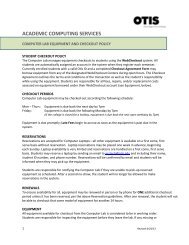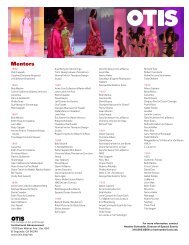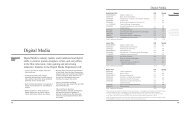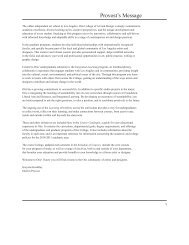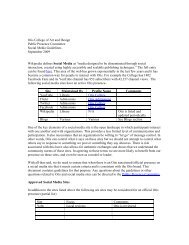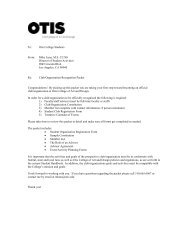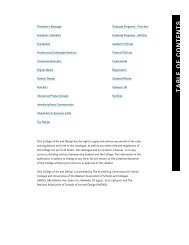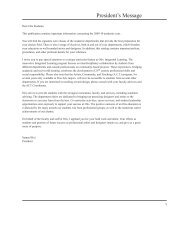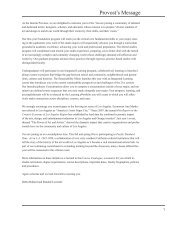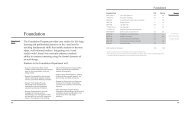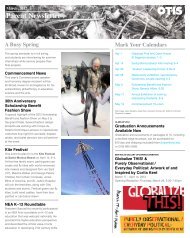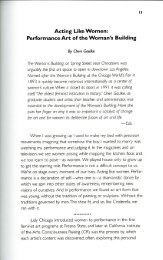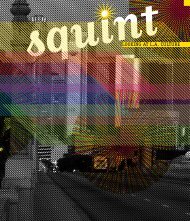Nike Sabbatical May 23, 2011 Jackie Wickser I. In this write-up I will ...
Nike Sabbatical May 23, 2011 Jackie Wickser I. In this write-up I will ...
Nike Sabbatical May 23, 2011 Jackie Wickser I. In this write-up I will ...
Create successful ePaper yourself
Turn your PDF publications into a flip-book with our unique Google optimized e-Paper software.
<strong>Nike</strong> <strong>Sabbatical</strong> <strong>May</strong> <strong>23</strong>, <strong>2011</strong><br />
<strong>Jackie</strong> <strong>Wickser</strong><br />
I. <strong>In</strong> <strong>this</strong> <strong>write</strong>-<strong>up</strong> I <strong>will</strong> discuss what I learned while at <strong>Nike</strong>:<br />
A. I learned how <strong>this</strong> 10 billion dollar apparel company is implementing an initiative<br />
to reduce its carbon footprint for climate neutrality in 2015:<br />
<strong>In</strong> my meeting with Rick MacDonald, head of <strong>Nike</strong>’s Considered Apparel<br />
department, he explained how <strong>Nike</strong> is integrating sustainability into product creation at<br />
every level (facilities, retail and business travel). Since <strong>Nike</strong>’s largest footprint is in<br />
materials and processes, that is where he began.<br />
The first step to the process of change is to find out where you are. Rick’s<br />
department has created a “Considered <strong>In</strong>dex Calculator”. This software measures the<br />
sustainability level of each style at the creation level. Each prototype is scored on<br />
their green use of material/ trim sustainability and processing (e.g. footwear-<br />
molding, heat, tooling, adhesives and solvents). The proto is then ranked where the<br />
best scores get gold, then silver or bronze categorizations.<br />
<strong>Nike</strong>s target for 2015 is 100% bronze on all new styles, including all of the top 10<br />
volume styles of each division.<br />
<strong>Nike</strong> has shared its Considered <strong>In</strong>dex Calculator with everyone interested.<br />
There are 3 companies testing it at the moment, one of them being Patagonia. The<br />
possible end result is hangtags with scorecards displaying the garments’ inherent<br />
level of sustainability. It is predicted that consumers <strong>will</strong> consider the environment as<br />
a purchasing criteria in the future.<br />
“We’re equally committed to leading our industry in climate change and<br />
sustainability. We’re entering a new era of open source collaboration that commits to<br />
sharing intellectual and patent property. It’s the kind of behavioral change that can<br />
help lower carbon emissions, reduce waste, and close the loop on the resources<br />
required by product manufacturing.”<br />
Mark Parker, <strong>Nike</strong> CEO, 7/28/09<br />
B. While at <strong>Nike</strong> I was brought <strong>up</strong> to date with the industry’s new machinery and<br />
software technologies.<br />
I met Sherry Hawkins, the director of the “Hive”, a place where all of the<br />
equipment for sampling is housed. Sherry is responsible for keeping the sewing<br />
and cutting equipment current with the factories and she oversees the prototyping<br />
for all <strong>Nike</strong> categories. Because <strong>Nike</strong> employs designers from the industrial sector,<br />
they have adapted some industrial machinery to the apparel process. This<br />
equipment works well with recycled polyurethane fibers.
•.<br />
1. List of equipment:<br />
• Ultrasonic line bonding which sews with sound<br />
• Presses for sublimation prints.<br />
• Dye-Sublimation which uses high heat and solid dyes to produce photo<br />
lab-quality images.<br />
• Dye-Sub printers which contain a roll of transparent film made <strong>up</strong> of pagesized<br />
panels of color.<br />
• Solid dyes in cyan, magenta, yellow, and black are embedded in the film.<br />
• Print head heating elements vaporize the inks, which adhere to a specially<br />
coated paper. As the ink cools it re-solidifies on the paper. Color intensity is<br />
controlled by precise variations in temperature. Because the color is<br />
absorbed into the paper rather than sitting on the surface, the output is more<br />
photo-realistic, more durable, and less vulnerable to fading than other ink<br />
technologies.<br />
• Bemus no sew seam bonding (tape adheres two pieces of fabric together<br />
without overlapping and bulk).<br />
• Bonding press (applies film to areas of a garment in order to lock the<br />
stretch)<br />
• Digital Vacuum cutter (laser for cutting bonding film, see sublimation<br />
prints above)<br />
• Tushima Embroidery machine<br />
• Santory Circular Knit Flatbed Knitting machine<br />
• Multi-needle Waistband Machine<br />
• 12 needle (uses fluff thread so that it won’t chaff)<br />
• Flat Seam Cover stitch<br />
• Customization for pro combat (grid and foam) Basketball and football<br />
undergarments/ injuries determine placement.<br />
2. Three dimensional computer technologies at <strong>Nike</strong> are used solely to assist with<br />
the concept process of design. The end result is more exact d<strong>up</strong>lication at the<br />
factory level and, in turn, fewer prototypes required. Illustrations are sent to the<br />
factory and the factory sends a digital proto back. A physical prototype is made<br />
only after the digital proto is approved:<br />
• Optitex 3D sketching (Style lines can be digitally taped onto Blocks)<br />
• V Stitcher (apparel simulation/ digital sewing room) sews pattern pieces<br />
together virtually. Fabric weight, bend, stretch, and bias have to be inputted.<br />
• V Tech 3D figure (Spinning movie of garment to show graphic design and<br />
engineered prints)<br />
• V tech Motion Capture - Match it with Avatar and simulation of garment<br />
on body and in motion. High definition video conferencing with factory<br />
while fitting.
C. Sitting in on garment fittings and global production meetings gave me a glimpse into<br />
how <strong>this</strong> huge apparel company is now meeting the global challenge of outsourcing.<br />
D. Management style: how to keep products fresh and innovative while keeping them<br />
relevant. Through meetings with division heads, I got an idea of how <strong>this</strong> huge operation<br />
works together and how they implement change from the top down.<br />
I. Division Heads I met with and their departments:<br />
Devon Burt, Global Creative Director<br />
Susan Rowan, Global Outsourcing Trims and Processes<br />
Mark Charlton and Rene Frei, <strong>Nike</strong> Women’s Sportswear<br />
Dana Waltrip, Global Fit<br />
Scott Williams, Global <strong>In</strong>novative Director Advanced <strong>In</strong>novative Technology<br />
Sherry Hawkins, Director of the Hive<br />
Diane Curry, Product <strong>In</strong>tegrity and Quality Engineering<br />
Michelle Miracle, Design Director Athletic Training<br />
Janice Slonecker, Design Director Young Athletes<br />
Rick Macdonald, Considered Apparel Lead<br />
Cheyrl Millard-Nutt, Sports Performance Materials Merchandiser Design<br />
Ed Thomas, Director of Advanced Materials Research<br />
Jerrett Reynolds, Design Director <strong>Nike</strong> Sportswear<br />
And many more…<br />
II. Projects I accomplished while at <strong>Nike</strong>:<br />
A. I helped the Athletics division reduce the carbon impact on the environment by<br />
eliminating 2 to 2 ½% of the waste left on cutting tables for the Men's hooded fleece<br />
pullover. This garment is a reorder item with over 100,000 pieces per cut. I completed a<br />
study on how to improve the marker efficiency by strategically placed seams.<br />
B. I was there to elevate apparel expertise, helping leverage a high degree of applied arts in<br />
product creation. Just some of the projects I worked on:<br />
1. I prepared and presented a draping seminar to 36 technical designers from many<br />
divisions. The lesson was in draping a raglan without a shoulder dart or over arm<br />
seam. This sleeve type was an area of confusion for the technicians across the<br />
board.<br />
2. I helped refine the fit and construction of the M-98 Women's sportswear jacket.<br />
I reviewed the samples from New York in regards to construction and fit.<br />
3. I developed a commercial prototype of a running jacket designed by Aitor Thorp<br />
for the 2012 Olympics.
4. I worked with Guillermo Raphael in the Advanced <strong>In</strong>novative Technology<br />
department to develop a new stretch stitch based on an old school hand sewing<br />
technique called "couching". The TLMX-120 Toshima Embroidery Machine was<br />
adapted to couch elastic cording while retaining the inherent stretch of the fabric.<br />
5. I developed jacket blocks for athletes Maria Sharapovich and Serina Williams.<br />
6. I collaborated with an advanced technology designer to come <strong>up</strong> with an<br />
alternative solution to knit for movement. This is because knits are more material<br />
wasteful than wovens in that the weave chains and thus use more yarn. Working<br />
with the structure of a garment we came <strong>up</strong> with a woven garment, which had a<br />
wider range of motion than a knit.<br />
My <strong>Sabbatical</strong> at <strong>Nike</strong> was truly inspirational. Being around the many brilliant and highly<br />
ethical individuals at <strong>this</strong> company gave me an ideal vision of what a product manufacturer<br />
could become.<br />
I want to thank Otis for the opportunity to grow and expand my horizons, which <strong>will</strong> most<br />
certainly be passed on to the students.<br />
<strong>Jackie</strong> <strong>Wickser</strong>, Associate Professor, Senior Class



